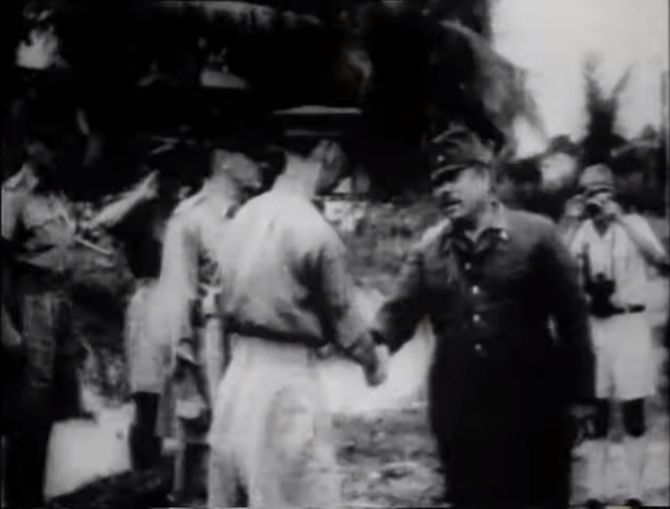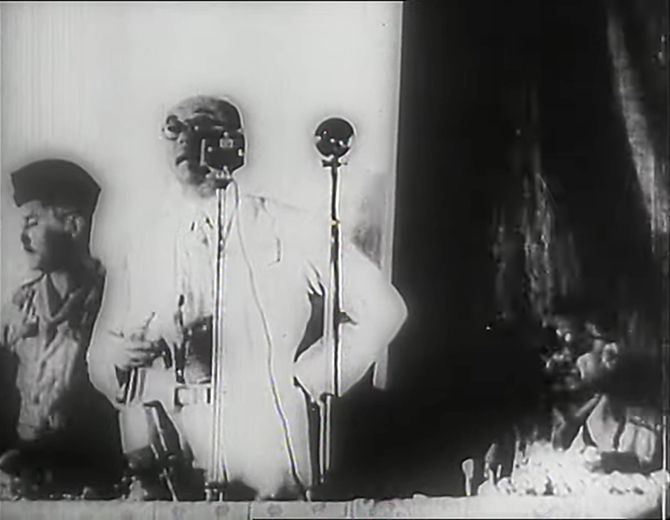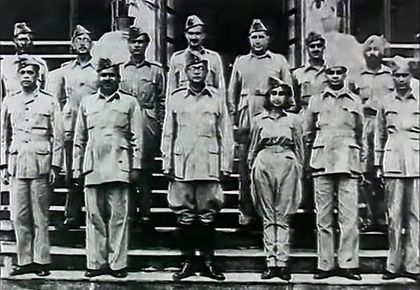Twenty two years before Kabir Khan's The Forgotten Army streams on Amazon Prime on January 24, 2020, his documentary of the same name was telecast on Doordarshan.
On that occasion, Kabir Khan spoke to Amberish K Diwanji/Rediff.com about Netaji's Azad Hind Fauj and its many battles for India's freedom.

The Forgotten Army is an attempt to tell a story not yet told.
Few know about those brave men and women who joined the Indian National Army and heeding the brave words of Netaji Subhas Chandra Bose -- 'Chalo Dilli! (Head for Delhi!) -- took on the might of the British empire.
Oddly enough, this 105-minute television documentary (broken into five episodes) did not start out as such.
For Kabir Khan, the creator of this saga, it all began one day in 1994 on the sets of the film, Beyond the Himalayas, which followed the Great Silk Route from Bukhara, through China, to Mongolia.
"I thought of making a similar travelogue, tracing the famous march of the INA from Singapore up to Imphal."
But destiny had other plans.
Khan began researching, only to discover that there was precious little available on the INA, either by way of history or literature.
And the Netaji Research Bureau in Calcutta, manned by Dr Sisir Bose, Netaji's nephew, turned out to be rather unhelpful, dismissing Khan and his queries when he first approached them in 1996.

Khan then turned to the survivors of the INA, the well-known Colonel Lakshmi Sehgal, and the media-shy Colonel Gurbaksh Singh Dhillon.
The latter, incidentally, was one of the three (the other two being Shah Nawaz Khan and Prem Kumar Sehgal) who were tried by the British in the famous Red Fort trial in 1946, a case that shook India and even united the bitterly warring Congress and Muslim League.

With Colonel Dhillon and Colonel Lakshmi by his side, Khan realised he had a golden opportunity to recapture the saga of an army that India has forgotten and Indian history, under Nehruvian policies, has ignored.
"The film is not about Netaji Subhas Chandra Bose, though, of course, he is mentioned in the film," stressed Khan, "It is the story of the INA, of its formation and its march through Burma right up to the eastern edge of India."
The film is shot through the eyes of Colonels Dhillon and Lakshmi, the senior-most survivors of the INA.
According to Khan, the entire shooting was an unforgettable experience, and especially for Colonels Dhillon and Lakshmi.
"There were times when I'd get goose pimples, so you can imagine what it must have been for those two and the other INA veterans who joined us during the shooting," he recalls.
Both Colonels Dhillon and Lakshmi were returning to Burma after 50 years, journeying into a misty past full of glory and honour.

What made the shoot even more poignant is the fact that much of Burma seems to be caught in a time warp, with little having changed from the 1940s when the INA headed for Delhi.
"There would be moments when Colonels Dhillon or Lakshmi, or some of the others INA veterans would see a hut or a particular road, their misty memories would clear and they recall having seen it way back then," said Khan.
"For most of the time, they were literally in a trance, remembering details and the experiences that they had.
It was truly fantastic!"

The favourite episode (which is also in the film) is the part concerning 86-year-old Dr Montu Bannerjee, who was the medical supply officer and a close associate of Netaji.
Dr Bannerjee had lost touch with the rest, choosing to stay back in Mamyo, a hill town in north Burma (near India).
Incidentally, the INA leadership shifted their headquarters from Rangoon to Mamyo when the INA troops neared the Indian border.
Recalls Khan, "We were in Mamyo in 1996 when this old man suddenly walks up to our unit, holds Colonel Lakshmi in his hands, and exclaims: 'Oh Lakshmi! The most beautiful woman in the world!' Dr Bannerjee had heard about the unit's presence and come to meet them.
It was a touching moment for everyone present.

"Then Colonel Lakshmi remembered that Dr Montu used to play the harmonica quite well.
And to the unit's utter joy, Dr Montu took out a harmonica from his pocket and began playing the Quami Tarana (Kadam Kadam Badaye Jaa, Khushi Ke Geet Gaye Jaa) which had been chosen as the national anthem by Bose," added Khan.

Khan's crew was the first television or film unit allowed into Burma.
"Before us, BBC, Channel 4, and umpteen others were not allowed inside Burma. So we were lucky to be allowed because we were able to capture authentic shots," he says.
Yet it was not smooth sailing.
The unit was placed under house arrest for 14 days in Mamyo, but later allowed to shoot unhindered.

The unit set out to recreate the long march beginning from Singapore.
Few people know that the INA was established a year before Netaji entered the picture in 1942.
It was set up at the behest of Mohan Singh, an Indian serving in the British Indian Army who had been captured by the Japanese.
"Netaji then was still in India, though later he would escape to Germany," said Khan, "and from Germany, he would fly down to Singapore to take charge of the INA."

On February 15, 1941, the 90,000-strong British army in Singapore surrendered to a Japanese army just 30,000 strong.
Among the captured British army were about 50,000 Indian troops, who were separated and taken to Ferrar Park, a huge ground where football matches are held.
This became the first gathering of the INA, commanded by Mohan Singh, who had been captured by the Japanese earlier.

Is there any memorial at Ferrar Park?
"None," said Khan, "there is only one memorial in Singapore at Pedang (which means an open ground in the Malaysian language)."
There was originally a huge memorial at Pedang, but when Singapore was recaptured by the British under Louis Mountbatten, it was blown up.
"Much after Independence, at Nehru's request during a visit to Singapore, another small memorial, the size of a desk, was built," says Khan.

The turning point in the INA's life came when Bose took command and gave his first address to the fledgling INA at Cathay Cinema, which stands till today.

"When we were at Cathay Cinema, Colonels Dhillon and Lakshmi were really caught up with the moment."
"Colonel Dhillon pointed to the spot where he had sat while Bose was speaking, Colonel Lakshmi too did the same," says Khan.

From there the movie begins to trace the march.
The film is shot in the present, with Colonels Dhillon and Lakshmi, and in flashback.
Khan has used archival material from the Films Division, Bombay, and the Imperial War Museum, London, to recreate some famous scenes and shots.
Khan is dismayed by the fact that India has done little for these brave men who did so much for their motherland.
"They were not given the freedom fighters pension until the mid 1960s, by which time many of them were dead," he laments, "we found some INA veterans actually living in slums in Burma."
As Khan points out, besides the soldiers, many Indian civilians living in Malaysia and Singapore, descendants of the indentured labourers who had been sent by the British to work on plantations, also joined the fight to liberate their motherland.
"These were poor and ordinary people, mostly South Indians, who had never seen India, only heard about it from their elders.
Yet they gave up everything on Netaji's call, just to fight for the country of their origin," said Khan, clearly in awe by all that he has learnt from his research.

What came out most clearly during the shooting was the immense awe in which the INA held Bose.
"He was akin to a virtual god for the INA people."
"They would remember small things like he had looked at them, or just nodded at them. Of course, if he spoke to anyone, it was manna from heaven," says Khan.
"There is no doubt that he had a tremendous personality, something one can make out from old films and footage, but alive, he must have been incredible!"

Ditto for the INA, whose valiant struggle was blacked out by the British during World War II, leaving most of India ignorant about it.
"The INA saga burst on the public consciousness only when the British put up Colonels P K Sehgal, Shah Nawaz and Dhillon for trial at the Red Fort," said Khan, "And this was a big mistake, because they had chosen three of the best officers, men of honour and integrity.
"Colonel Shah Nawaz had won the Sword of Honour at the Indian Military Academy, Colonels Sehgal (Colonel Lakshmi's husband) and Dhillon were highly-respected officers."
"The British could have easily chosen some of the lumpen elements who had joined the INA."

Bose's decision to ally with Germany and Japan has been criticised by many over the years.
Khan is at pain to point out that his film makes no value judgement.
"This film is just about the 50,000 persons who made up the INA."
"In fact, the film clearly states, 'This is the story of those who returned'."
"They are part of our history and I just want to tell their story," he stresses, adding, "It is also not a definitive history of the INA."
The last bit is quite a bother for Khan who has been receiving calls from various quarters asking why so-and-so has not been shown in the film or why some aspect was left out.
"How can I show everybody or everything?" he asks, "I keep telling them that this is just a story as seen through Colonels Lakshmi Sehgal and Dhillon."

An unresolved debate is whether the INA made any contribution to the Freedom Struggle.
Khan is convinced that the INA did make a difference, even if it amounts to just two per cent of the entire movement.
"The INA had no illusions about capturing Delhi with just 50,000 badly equipped men against the mighty British armed forces," says Khan.
"Their aim was to reach Assam and once there, they were sure that the whole of India would rise up against the British."
"And the fact that that this rag-tag army reached Imphal, just a few miles short of Assam, speaks volumes for their courage and conviction."
While what would have happened had the INA crossed Imphal into Assam cannot be answered, Khan points to the famous Naval Mutiny in 1946, partly inspired by the INA and the Red Fort trial.
"All these events must have scared the British and forced them out even faster," he says.

In Burma, Indian troops also fought in the British army against the Japanese, and the INA.
Did the two Indian forces face each other?
"There is one instance when an Indian regiment under the British was fighting and they heard the other side cry out 'Chalo Dilli!' So the Indian troops began to wonder about their enemy speaking in Hindi."
"This, in turn, forced their British officer to use the Lancashire Regiment, which had no Indians in it, against the INA the next time round," says Khan.
It is a film worth watching, if only to remember those brave men and the thousand women of the Rani of Jhansi Regiment, commanded by Lakshmi Sehgal, whose only aim was to see their homeland free.



















 © 2025 Rediff.com -
© 2025 Rediff.com -